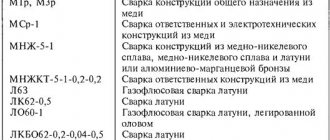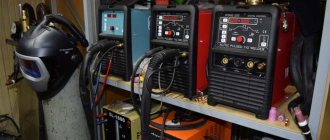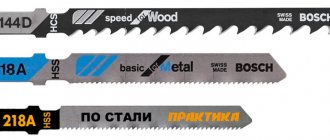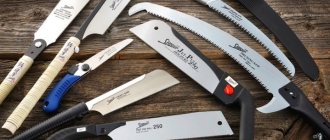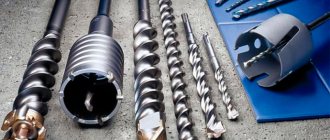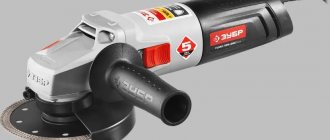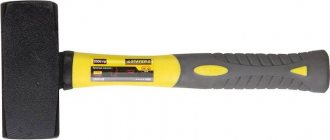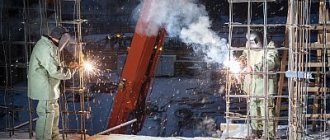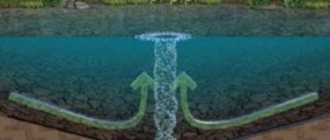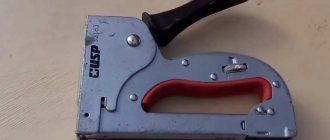Electric arc welding
Electric arc welding machines are the most widely used. To heat and melt the metal, an electric arc is used, which is a discharge between the cathode and the anode. In this case, high-power thermal energy is released. By acting on a metal workpiece, it leads to its melting with the subsequent formation of a weld pool.
After the arc dies out, cooling and crystallization of the melt immediately begins. As a result, a joint is formed in composition and strength comparable to the metals that were welded. There are several types of electric arc welding.
MMA – manual arc welding
Used with piece electrodes, which are a metal rod coated with coating. The process takes place under the influence of direct or alternating current. The coating of the consumables melts, releasing gases that form a cloud to protect the welded metal from oxidation. In addition, various chemical compounds are included in the coating, which serve as an additive to the weld pool to change the properties of the weld and support stable burning of the electric arc.
Devices - inverters, rectifiers, transformers - allow you to perform work in any spatial position. If you choose the right consumables, you can weld any metals: ferrous, non-ferrous, alloyed, etc. It is important to emphasize that the holders can penetrate into hard-to-reach places where the use of other types of welding is impossible.
MMA welding is suitable for both professionals and beginners. It is widely used in construction, installation of metal structures, in various branches of heavy industry, and in private entrepreneurship. It is necessary for a small workshop for the production of metal structures, a car service station, or a large engineering plant. It is indispensable on the farm when you need to construct something out of metal yourself or repair a leaky metal frame.
Principles of Welding Classification
The number of methods and types of welding of various materials has confidently exceeded one and a half hundred. In order to weld metals efficiently, it is necessary to choose the right welding method. The classification of welding types will help with this. There are many “homemade” classifications that create chaos in this matter and contribute to the purchase of equipment that does not meet the assigned tasks. The only correct approach should be considered the practice of classification according to the principle of physical impact, the degree of technical support and the use of various technologies.
Signs of physical impact
To determine the welding class, it is necessary to consider the form of the applied energy.
There are three classes of welding:
- thermal;
- thermomechanical;
- mechanical.
The thermal class combines processes occurring through the use of various types of thermal energy. The largest amount of work in this class is performed by arc and gas welding . These two types are required in any industry related to the creation of metal structures or their repair.
The thermomechanical class involves two types of influence: heat and pressure. A striking example is resistance welding , when electrodes simultaneously heat and compress parts. Other representatives of this class are much less common: arc press, diffusion and forging .
The composition of the mechanical class is not large, but quite interesting. On the one hand, these are cost-effective types of welding, but on the other hand, they require such specific conditions that they have a very small scope of application. The economic benefit is due to the lack of heating. This class includes cold pressure welding (hyperbaric), friction welding, ultrasonic welding and explosion welding .
Technical features
The following principles are used for this classification:
- principle of protection against oxidation;
- continuity of the process;
- level of mechanization.
The quality of the seam depends on the degree of protection against oxidation. The most common technologies are welding in a protective gas environment. Protection with flux, foam and various combined methods is often found.
The classification of welding types according to the continuity of the process does not require much explanation and has only two types: continuous processes or intermittent ones . In terms of the degree of mechanization, they also didn’t make much of a difference and settled on the following classification option:
- manual;
- mechanized;
- automated;
- automatic.
Classification according to technological principles
According to technological principles, types of welding are classified depending on what technologies underlie the welding process. This is a very ramified and not without contradictions classification, which is constantly refined and updated. For example, arc welding technology is singled out as a separate type; here it is divided into mig/mag, m ma, tig , which, in turn, are divided according to the type of welding current, diameter and type of electrode and many other characteristics.
Gas plasma
In this case, the metal of the workpiece melts under the influence of the temperature of an open flame. It is formed as a result of the combustion of oxygen with flammable gases - hydrogen, propane, butane, acetylene and others. MAF is considered the most effective - methyl acetylene fraction. It is characterized by a high flame temperature (2927 degrees) in oxygen and, accordingly, higher heat transfer. The combination of oxygen and MAF is inferior in toxicity to cyanogen (combustion temperature 4500 degrees) and is less explosive compared to acetylenedinitrile (combustion temperature 5000 degrees).
An open flame as a heat source for welding has an important advantage: it is independent of the power supply. Therefore, the technology is widely used in “field” conditions. Another advantage is the gradual heating of the metal, which is practical when working with sheet materials. The method is unsuitable for industrial use due to the impossibility of automation and low productivity. To work with such welding, the operator requires extensive welding experience.
Argon arc welding
If you need to weld a steel structure, then, without thinking twice, you will pick up a welding machine and easily cope with this task. But what to do if welding work needs to be done, for example, for an aluminum structure? This is where argon arc welding can help you.
Argon arc welding is welding using an electric arc in an inert argon environment. Consumable or non-consumable electrodes can be used for this welding. A tungsten electrode is most often used as a non-consumable electrode.
The arc burns from the workpiece being welded to a non-consumable electrode (as already mentioned, most likely tungsten). The electrode is fastened to the burner, through the nozzle of which protective gas is supplied. The filler material is supplied to the arc zone from outside and is not included in the electrical circuit.
Argon welding can be performed in manual mode, when the welder controls the torch and filler rod, and in automatic mode, when the movement of the torch and filler wire is carried out without the help of a worker.
When welding with a non-consumable electrode, unlike welding with a consumable electrode, during ignition of the arc the electrode does not touch the product for such reasons. To begin with, argon has a high ionization potential, for this reason ionization of the arc gap using a spark from the electrode to the product is a rather difficult task.
In the case of argon welding using a consumable electrode, after the wire touches the part, the arc zone is saturated with metal vapors, which have an ionization potential almost three times lower than that of argon, as a result of which the arc is ignited.
In addition, if the part touches the tungsten electrode, things such as contamination and intense melting will occur. For this reason, during argon welding using a non-consumable electrode, a device called an “oscillator” is connected in parallel to the power supply network to ignite the arc.
Using an oscillator, to ignite the arc, high-frequency high-voltage pulses are supplied to the electrode, ionizing the arc space and ensuring ignition of the arc when the welding current is turned on. If argon welding is performed with alternating current, when the arc is ignited, the oscillator begins to work as a stabilizer, supplying pulses to the arc when the polarity changes.
This is necessary to prevent deionization of the arc space and ensure stable arc combustion.
During DC welding, the anode and cathode produce different heat. When currents are less than 300 A, the anode generates more heat than the cathode, 70 to 30 percentage, for this reason straight polarity is usually used to ensure maximum penetration of the part and minimal heating of the electrode.
When welding all steels, titanium and other materials except aluminum, straight polarity is used. When welding aluminum, alternating current is used to improve the destruction of the oxide film.
Argon is sometimes mixed with 3–5% oxygen to reduce porosity. This causes more active protection of the metal. Argon in its pure form protects the metal from phenomena such as moisture or other inclusions that enter the welding zone. And with the help of oxygen, harmful impurities are burned out, or released outside. And this helps fight porosity.
Electroslag
The edges of the parts melt due to the heating of the slag from the flux melted under the influence of electricity, which is previously poured between the elements to be welded. During the process, wire or filler rod is used. The technology is in demand for joining parts made of cast iron, and less commonly for welding non-ferrous metals.
This type of welding is in demand in industry for connecting large parts with thick walls (40-500 mm): rotor and turbine shafts, supports, steam boilers, etc. The greater the area of the welded surface, the greater the economic benefit from this welding method.
Characteristics of argon welding
Sometimes it becomes necessary to fuse metal elements that cannot be joined by conventional types of welding, for example, parts made of aluminum, titanium, and copper. To make the structure durable and reliable, argon technology is used.
This type of welding combines the properties of the electric arc and gas methods - it is necessary to use an electric arc, use gas and some technological methods for forming a seam.
When argon arc welding of metals, the inert gas argon is used. It covers the area where the seam is formed and provides reliable protection against the oxidation process that can occur from the contact of metal surfaces with oxygen contained in the air. Argon does not allow oxygen to penetrate into the area of mating surfaces.
Welding operations can be carried out in manual, semi-automatic or automatic mode. Depending on the mode, two types of electrodes are used: consumable and non-consumable. The latter uses tungsten wire, which ensures the strength of the connection even between dissimilar metals.
Advantages of argon arc welding technology:
- The low heating temperature allows you to maintain the size and shape of the elements being welded.
- The inert gas argon is heavier and denser than air, it provides reliable protection of the weld formation zone from the penetration of oxygen.
- High arc heating power allows you to perform welding work in a short period of time.
- The simplicity and accessibility of welding technology allows you to quickly master skills.
Disadvantages of argon arc welding technology:
- Argon evaporates in strong winds and drafts. This leads to reduced protection and deterioration in seam quality. There is a need to carry out argon welding work in well-ventilated areas.
- The complexity of the equipment makes it difficult to configure modes.
- When using a high-ampere arc, additional cooling of the metals being connected is necessary.
The main advantage of argon-arc technology is the ability to permanently join metal elements even in cases where the use of other types of fusion does not produce results.
Plasma
The plasma jet, which is generated in the plasma torch or between the surface of the workpiece and the electrode, melts and connects the edges. The method is characterized by a large depth of processing of parts and high welding accuracy. It is in demand for connecting both small and thin-walled elements of electrical structures and large blocks for heavy industry. Plasma effectively affects all types of metals without exception.
In addition to those considered, thermal types of welding include:
- laser;
- contact butt with reflow;
- electrobeam;
- with embedded heaters.
Thermo-mechanical welding of materials
Thermo-mechanical welding includes forge, contact and similar types. These methods of welding metal simultaneously use thermal and mechanical energy. This type of technology includes the following:
- blacksmith's;
- contact;
- diffusion;
Forge welding is a method in which the products to be welded are first heated to the required temperature in a forge, and then connected to each other with a hammer. If a press is used instead of a hammer, then this method is called a pressing method.
The contact type has this name due to the fact that welding is carried out at the point of contact of the parts being connected. They are pressed tightly against each other using special electrodes, and then a powerful current is passed through the compression point.
At the point of contact, the greatest resistance is obtained, which causes the main heat to be released at this point. Accordingly, this leads to melting of the metal at the point of contact. Using contact welding, spot or seam welding is obtained.
Resistance welding has become widespread in mechanical engineering, especially in the automotive industry. This is due to the high productivity and cost-effectiveness of this type of welding. It is the easiest to automate and is widely used in robotic systems.
It is impossible not to mention the diffusion type of welding. Its essence lies in the preheating of the workpieces and their subsequent connection using deformation that occurs from mechanical pressure. In this process, atoms diffuse from one part being connected to another and an inextricable connection is obtained.
Types of welding work
The classification of welding is related to the equipment used, as well as the method of execution.
According to the method it happens:
- manual;
- semi-automatic;
- automatic.
Manual means the use of electrodes that become hot and heat the structure being processed. This is exactly the kind of work for which the skill of a welder is important. By manual welding, you can connect parts in hard-to-reach places and form seams that cannot be made with machines.
Semi-automatic - welding with the supply of wire into the weld zone at a given speed and with the treatment of the welded area with inert or active gases to protect the metal. The seam is more accurate and of higher quality. The work is progressing quickly.
Automatic is more often used in production. It is mechanized or even robotic. It maintains even burning of the arc, making the seam as even, neat, and durable as possible.
What applies to welding work?
Welding can be very diverse in terms of consumables and equipment used.
Arc welding
The simplest and most common type of welding. It requires electrodes, between which an electric arc appears. It is this that serves as the source of heat for melting the metal. Arc
- This is a discharge in a gaseous environment.
This is a universal welding method that allows you to join almost any metal. You can weld in any position, even in limited space. External conditions do not matter: welding can be carried out even in unfavorable conditions.
The downside is low performance
and
the difficulty of starting the arc
. When igniting, problems with the electrode sticking may occur. Also, this type of welding is harmful to the health of the welder due to the evaporation of the electrode coating. Arc welding requires experience and skill of the performer. Beginners cope with it poorly.
Modern equipment helps reduce risks and disadvantages. Arc welding requires transformers or inverters.
Electrodes are selected according to metal and diameter. For a reliable connection of the parts being welded, it is better that the metals of the part and the electrode are homogeneous.
The arc is ignited by striking or touching. Then it is necessary that its combustion be stable. To do this, the electrode is kept at a constant distance from the surface of about 2 millimeters. When the electrode burns out, it must be lowered. But you can’t bring it close to the metal, so as not to stick.
Gas welding
The edges of the parts to be joined are heated to the melting temperature with a gas burner. This type of welding is relatively simple, does not require expensive equipment or consumables, and consumes little energy.
Minus – low metal heating rate
. When welding thick parts, this speed is further reduced, so this method is used for welding sheets no thinner than 6 mm. Another disadvantage is the risk of warping. Gas welding joins almost any type of metal.
Electrodes are not needed here. Instead, there is filler wire. When heated, a weld pool is formed in the metal, which is protected by a gaseous environment. For welding, a mixture of acetylene and oxygen is used. For metals with a low melting point, methane, propane-butane can be used.
Argon welding
It requires electrodes made of tungsten, graphite, and carbon. You also need inert gas: argon, nitrogen, helium
. A mixture of gases may be used, depending on the metal being joined. The welding process requires alternating or direct current.
This is not the most productive welding, but it produces a very high quality weld. This is a labor-intensive process that requires the performer to have a lot of experience and attention to work. Argon welding is used if you need a very strong seam that can withstand increased load. For example, gas pipelines, tanks for the food industry, and high-pressure vessels are sealed in this way. Very thin-walled parts are connected in this way.
Submerged arc welding
Flux powders are used to provide the work area with protective gas. The flux protects the melt and ensures stable arc combustion. The process is automated: the powder is fed automatically, the equipment moves along the seam also automatically. This is a welding technique for mechanical engineering, shipbuilding, carriage building and equipment manufacturing. The seam is of high quality, resistant to increased loads and adverse operating conditions.
Gas plasma welding
Metal is melted with an open flame. To do this, oxygen burns with propane, hydrogen, acetylene, butane. This is field welding. It is low-productive and cannot be automated. The welder requires a lot of experience and skill.
Electroslag welding
Most often used for joining cast iron. Flux is poured between the elements to be joined, it melts and heats the slag. To form a seam you need a rod or wire. Such welding is needed for large-scale and thick-walled metal structures.
Electron beam
More modern technology. Parts and metal structures are heated and melted by the flow of high-speed electrons. Their movement occurs in a vacuum and is provided by an electric field.
contact welding
Technology for industrial mass production. The parts are heated by the current passing through them. At the same time, they are subject to pressure. The connection with this technique can be butt, suture, or point.
There are other types of welding: diffuse, forge, friction, with high-frequency current, with embedded heaters, laser, etc. But they all have a limited scope of application, requiring the use of specialized equipment and consumables, and special qualifications of the craftsman.
The choice of welding type depends on the parts being joined: the type of metal, its thickness, as well as the working conditions and the desired result.
